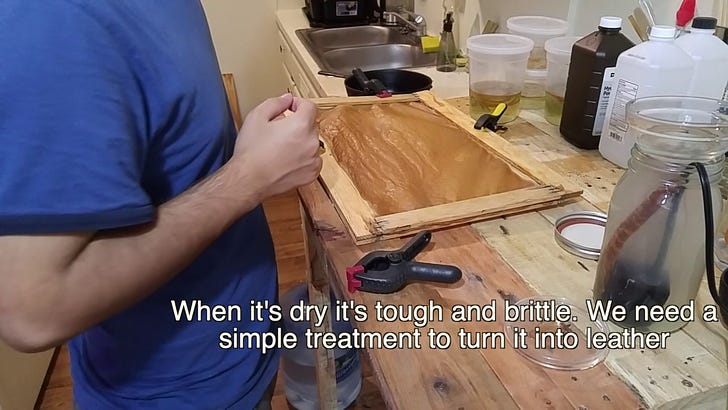Leather is, pretty objectively, terrible for the environment. Ignoring the animal welfare angle, raising cattle has an enormous ecological impact. The animals themselves produce greenhouse gasses, use up huge amounts of water, require large areas of space, pollute waterways, and eat massive amounts of biomass. While leather is luckily a byproduct of the meat and dairy industry, the act of tanning leather usually involves large volumes of extremely strong chemicals which are frequently dumped into the local water table.
Artificial leathers have their own problems, and also don’t last as well as true leathers.
So it’s not surprising that there’s a huge amount of research towards achieving the “Beyond Burger” of leather—I think what MycoWorks and Mylo are doing with fungus based leathers is fascinating. Piñatex is also pretty cool.
But that’s not what I’m here to write about.
Because there’s an all natural, low chemical, leather alternative you can make at home. But it looks like something from David Cronenberg’s fevered imagination.
Kombucha leather.
If you’re subscribing to this email, I’m betting you already have at least a passing familiarity with how kombucha is made at home—you have an enormous weird floaty creature called a scoby, you poor sweetened tea over it, and the scoby (more correctly SCOBY but cmon) eats the tea and puts out kombucha. But if you’ve had a long lasting scoby, you’ve probably seen it turn into a huge thick floating puck of biomass. Which is where the leather comes in.
Short version, you grow a scoby in a rectangular container, get it nice and thick, and then dry it out. And you have something approximating “leather”. You can also use oils to try and make it stiffer and more water resistant, as from what I gather it otherwise starts to disintegrate when wet. It seems you can also darken the stuff by heating it.
Which is good, because the best way I can describe how it looks is halfway between fried chicken skins and fruit leather. Like the remains of molting. Translucent beef jerky ass material. It somehow looks more like skin than leather made from actual skins.
(image from Iowa State)
The attempts I’ve seen to use it range from the “hey, that’s interesting” to “nice effort” to the offputting (see the jackets most of the way down this page). There are some people selling kombucha leather products on Etsy, but it primarily seems to be leather samples and basic earrings.
Hopefully, with more work, folks can get it the kombucha leather to the point where it’s more visually pleasing, and won’t go sticky and disintegrate when wet. Because how it looks now?
I’m going to stick with scoby fruit leathers instead.




